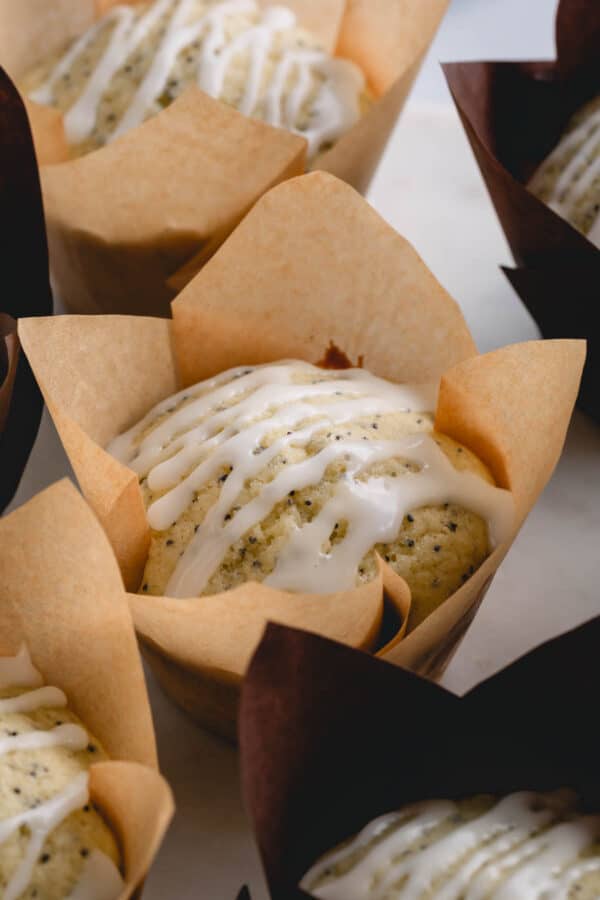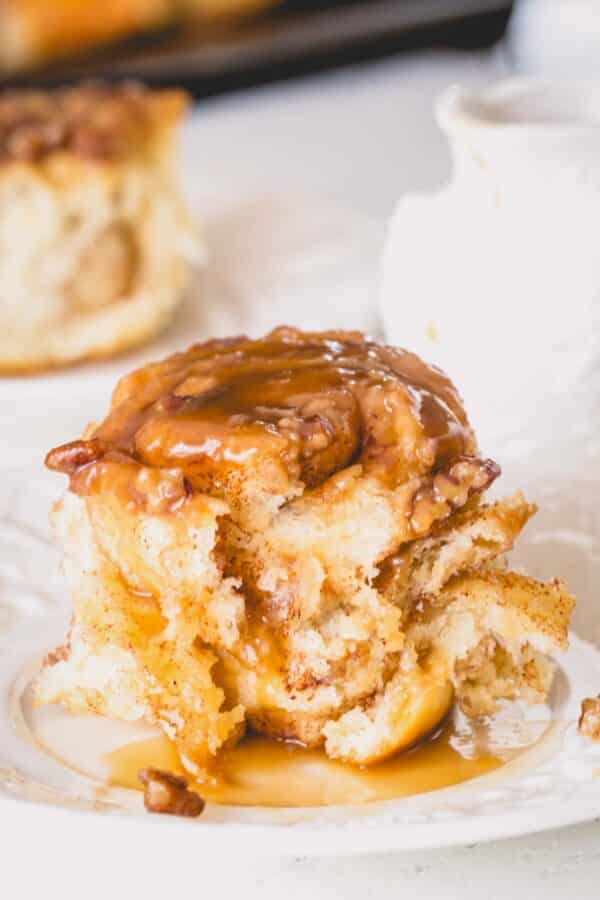Eggs Benedict with Homemade Hollandaise Sauce
This post may contain affiliate links. Read full disclosure.
This eggs benedict recipe is perfect for Sunday brunch, special occasions, or feeding a crowd. My buttery-rich homemade hollandaise sauce is whipped up in a blender with no whisking required for the perfect finishing touch!

Table of Contents
Pin this now to find it later
Pin ItWhy you’ll love this recipe:
Eggs benedict has been my go-to brunch order for as long as I can remember! I just can’t resist tender poached eggs topped with velvety hollandaise sauce. Every single bite is heaven!
- Learning how to make eggs benedict at home is easier than you think!
- I’ll teach you the secret to perfectly poached eggs (hint… it’s a ramekin and white vinegar) and how to make fail-proof hollandaise sauce.
- Homemade hollandaise sauce is a great way to use up egg yolks.
This classic breakfast recipe never fails to impress, and if you follow my easy eggs benedict recipe, you’ll master it on your first attempt!

Key Ingredient Notes:
hollandaise sauce
- Egg yolks – These form the base of the hollandaise sauce. They give the sauce its smooth and creamy texture and bind the ingredients together. To separate an egg yolk and egg white, crack the egg open over a bowl. Transfer the yolk back and forth between the two shell halves, letting the white drip into the bowl until only the yolk remains.
- Lemon juice – Freshly squeezed lemon juice lightens hollandaise sauce, balancing out the heavy and rich flavor of the egg yolks and butter. You’ll taste the citrusy, tangy flavor as well!
- Dijon mustard – A small amount adds more tangy flavor. Stick with Dijon, because it has the smooth and creamy texture you want for hollandaise sauce. Grainy mustard won’t incorporate into hollandaise as well.
- Unsalted butter – Melt the butter either in the microwave or on the stove over low heat in a saucepan. Avoid melting the butter too far in advance. It should still be hot when pouring it into the egg yolks!
poached eggs
- Eggs – The fresher your eggs, the better they’ll poach. It would be fantastic if you could get your hands on eggs from a local farm, but if not, just check expiration dates.
- White vinegar – This is crucial for achieving perfectly formed poached eggs! The vinegar helps firm the egg white when it hits the hot water.
assembly
- English muffins – You’ll need 1 whole English muffin per person. Regular, white English muffins are the traditional choice, but whole-grain options are fine, too!
- Canadian bacon – Canadian bacon is a protein source that resembles thickly sliced pieces of ham. However, it’s cured, meaning it’s fully cooked and just needs a quick reheating. If you can’t find Canadian bacon, regular bacon, ham, smoked salmon, or turkey bacon are good substitutes.
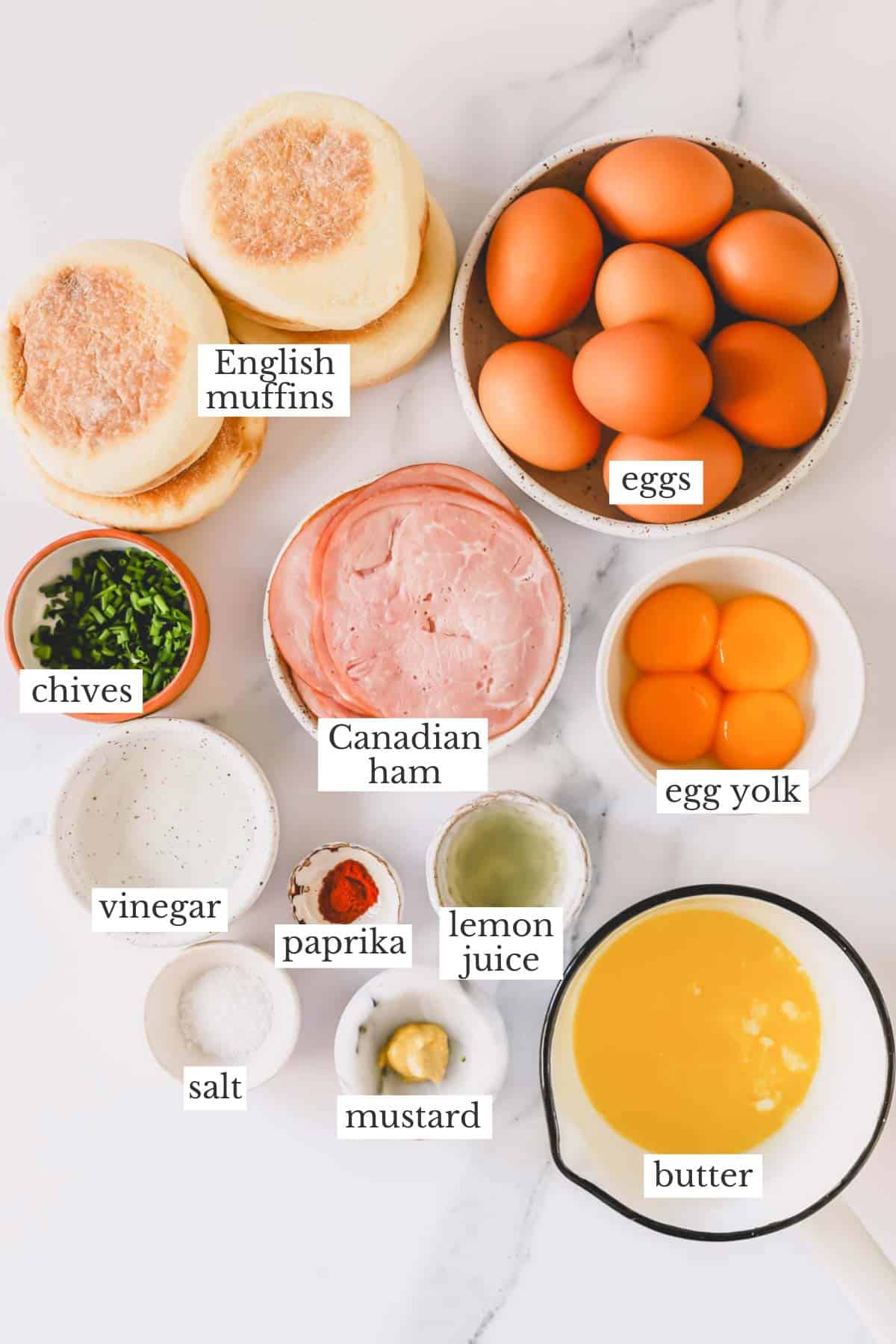
for egg poaching
Before you get started, make sure you have a small ramekin on hand for poaching the eggs. Ramekins are a game-changer for achieving perfectly poached eggs! Using a ramekin gives you better control when adding the eggs to hot water, ensuring they maintain their shape during poaching and the yolk doesn’t break when cracked.
How to make hollandaise sauce:
- Add the egg yolks, lemon juice, Dijon mustard, smoked paprika, and salt to a blender.
- Blend the mixture for 15-20 seconds or until frothy.
- Melt the unsalted butter in the microwave or a small pot.
- Slowly pour the hot melted butter into the egg yolk mixture while blending the sauce on low speed. You’ll notice the sauce thickens as soon as you add the butter.
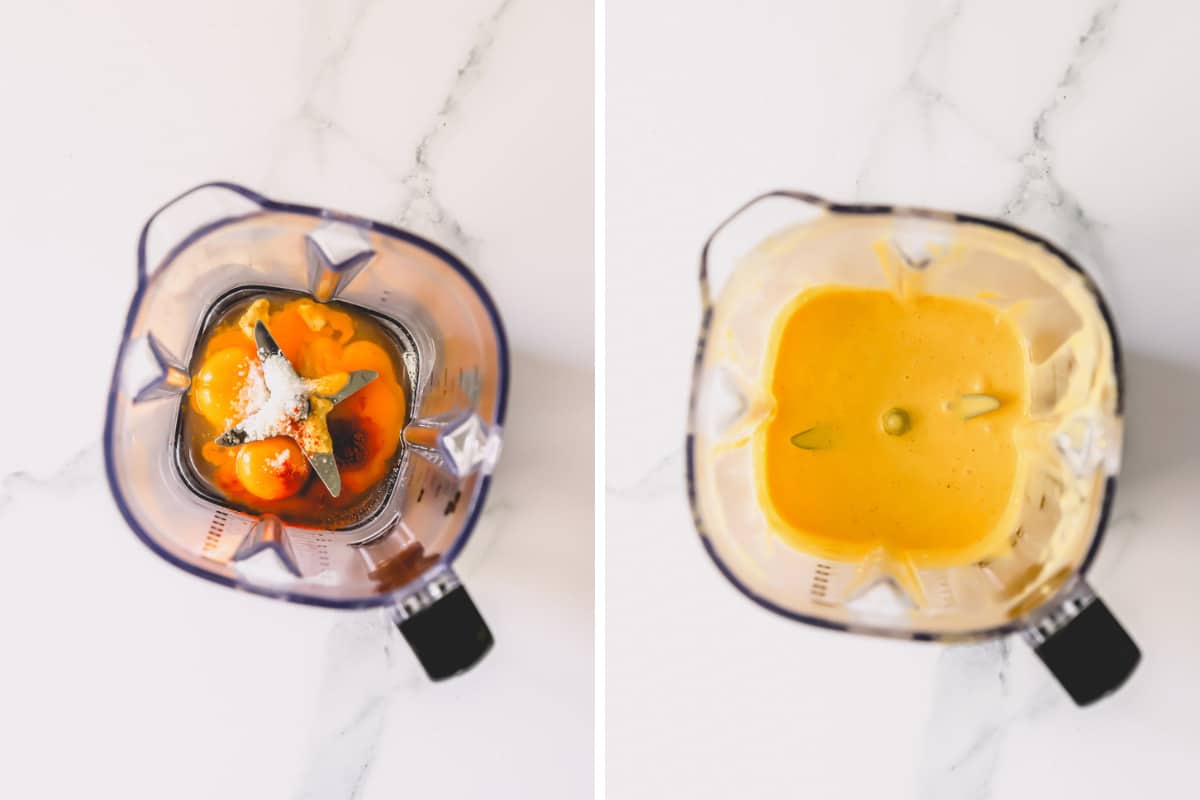
- Taste the sauce, and adjust the seasonings if needed.
- Pour the hollandaise into a glass jar, and serve it immediately. To keep it warm, cover the jar with a tight-fitting lid and place it in a large bowl filled with hot water.
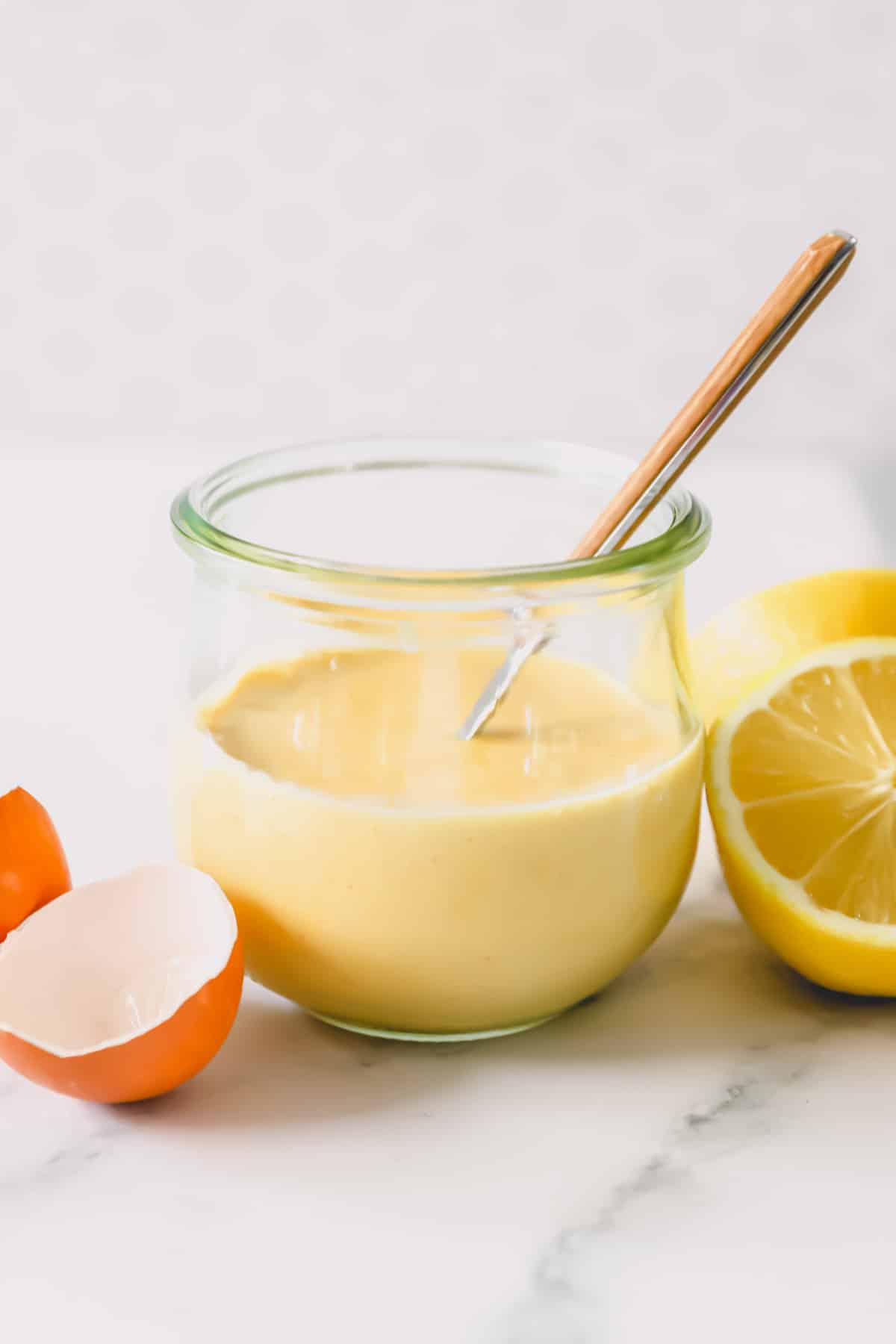
How to Poach Eggs:
- Crack one egg into a small ramekin, and set it aside. You only need 1 ramekin, because you’ll work in batches on this step!
- Fill a large non-stick skillet about 1 ½ inches deep with water or until the pan is about halfway full.
- Heat the water over medium heat until simmering, without allowing the water to come up to a full boil. Then, add the vinegar.
- Carefully tilt the egg into the simmering water. Crack the remaining eggs one at a time, pouring them first into the ramekin, and then into the simmering water. Complete this step in batches depending on how large your pan is.
- Cook the eggs for 4 minutes or until the white is set and the yolk is still soft.
- Carefully remove the eggs using a slotted spoon and transfer them to a plate lined with paper towels to drain.
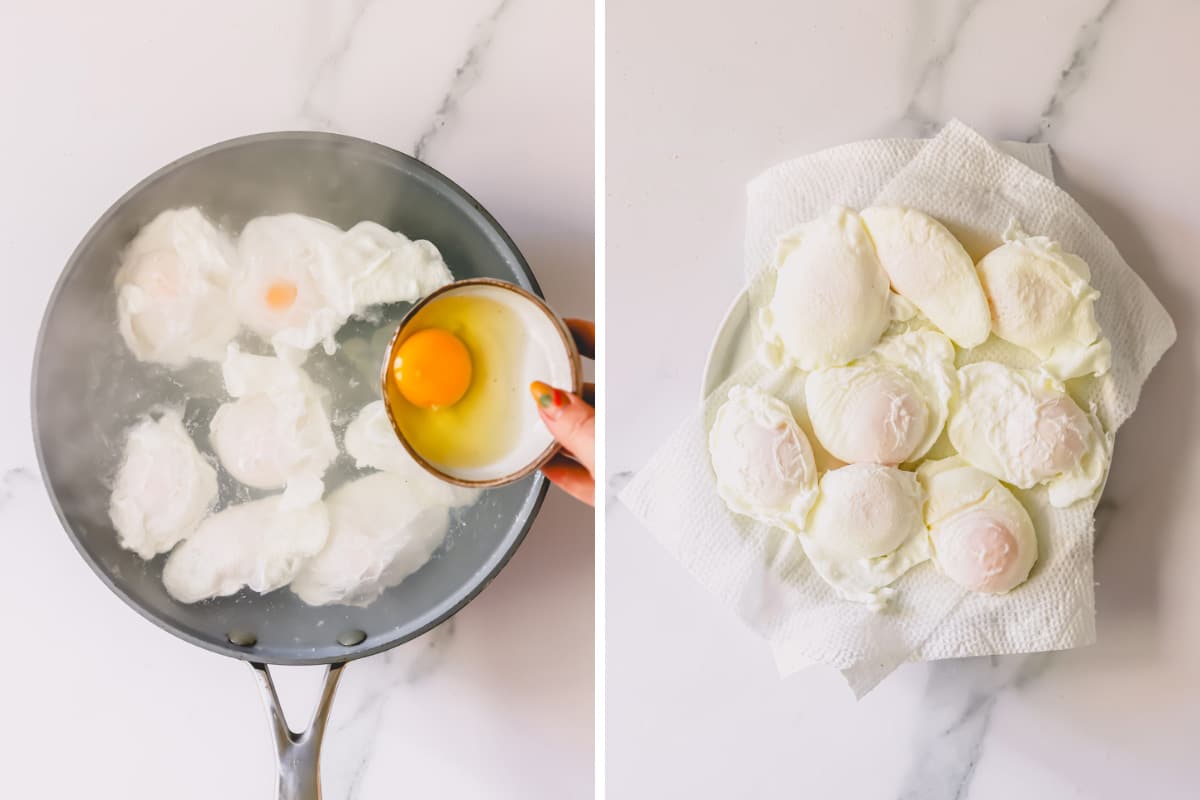
How to Assemble Eggs Benedict:
- Sear the slices of Canadian bacon in a hot skillet until the edges are golden brown and slightly crispy.
- Toast the English muffins while the Canadian bacon cooks.
- Top each English muffin half with a piece of Canadian bacon, a poached egg, and a drizzle of hollandaise sauce. Garnish with chopped chives, and serve with a side salad, fruit salad, or roasted potato wedges.

Tips for Success:
- Add a splash of vinegar to your poaching water. Vinegar quickly turns the egg whites into a solid, which prevents them from dispersing into the cooking water. It’ll give your poached eggs their signature round, plump shape and ensure none of the whites go to waste!
- Serve the hollandaise sauce warm for the best smooth and velvety texture. As the hollandaise cools, it’ll become overly thick and might even get a little clumpy. Time your sauce preparation correctly, or keep it warm in a hot water bath.
- Give the English muffins a good toasting! Feel free to toast your English muffins a little darker than normal. The moisture from the poached eggs and hollandaise sauce will keep them soft. If they’re undercooked, your muffins will become soggy from the egg and hollandaise sauce.
- Don’t worry if you don’t have a ramekin! Just use a small measuring cup instead. What’s important is finding an alternative, because you shouldn’t skip the step of cracking the egg into a dish before pouring it into the hot water.
Make-Ahead Tips:
While eggs benedict is best served warm and fresh, you can do a couple of things to help yourself out in the morning. The more time you have to sit and enjoy your coffee, the better, right!?
- Poach your eggs in advance. Poach the eggs as instructed in the recipe. Then, immediately transfer them to an ice water bath to stop the cooking process. Store the cooked eggs in the fridge for up to 12 hours. When you’re ready to serve breakfast, reheat the eggs in hot water for about 1 minute.
- Cook your bacon ahead of time. If you prefer regular bacon over Canadian bacon, you’ll save a lot of time by getting it cooked the day before. Fully cook the bacon, and store it in the fridge for up to 24 hours. Reheat it in the microwave when you’re ready to serve. Canadian bacon cooks up in a snap. So, it’s not necessary to cook that ahead of time.
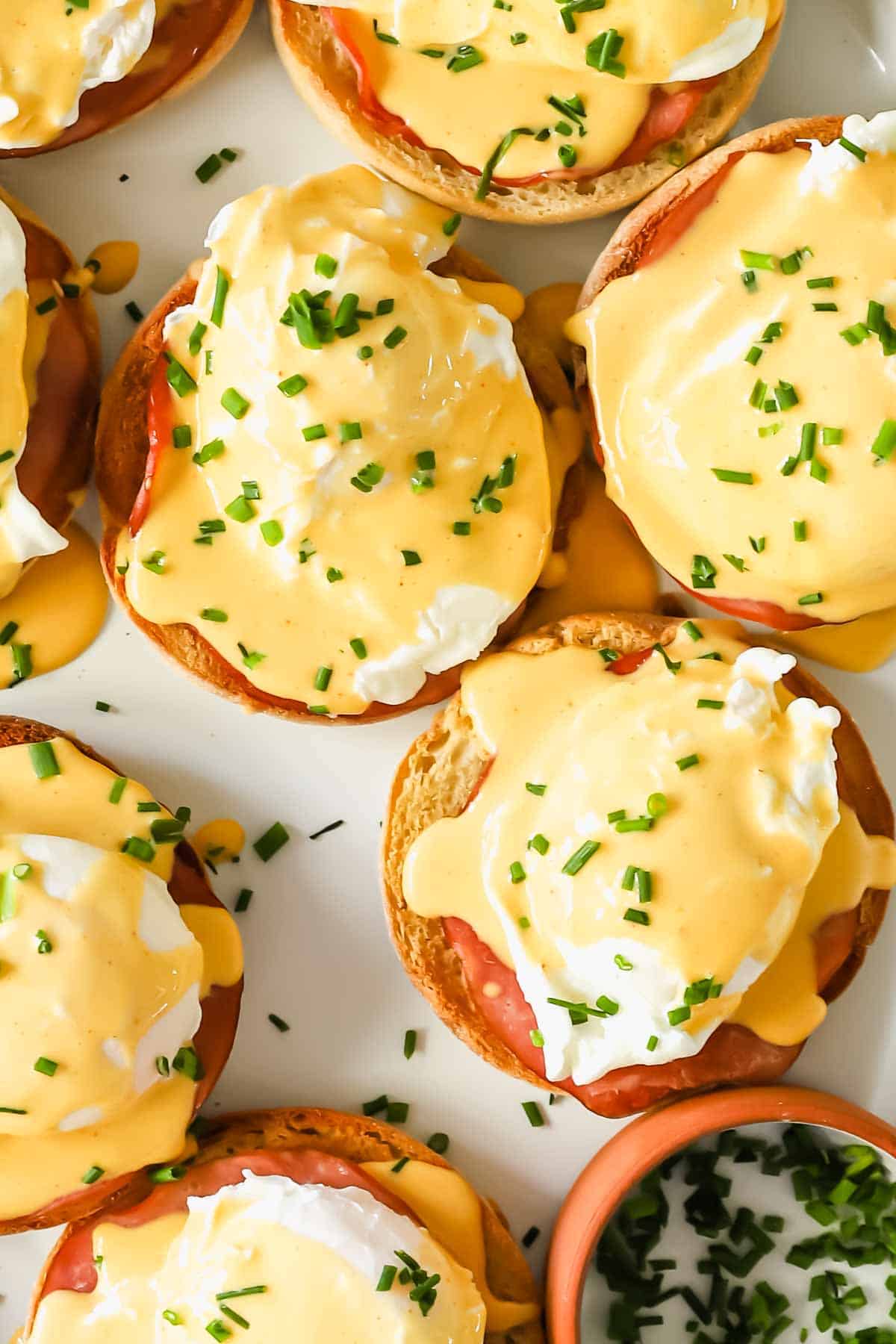
Storing Tips:
Eggs benedict and homemade hollandaise sauce are most memorable when hot and fresh. You’ll lose a lot of the magic if you try to reheat leftovers. But it can be done if you can’t stand seeing it go to waste!
- Store leftover eggs benedict and hollandaise covered in the refrigerator for 1-2 days. If possible, store components separately.
- Reheat leftover hollandaise sauce in a saucepan over low heat, whisking constantly. Warm poached eggs in hot water for about 1 minute. Canadian bacon can be reheated on the stove over low heat or in the microwave. Try to restore some of the crispiness of the English muffins by lightly toasting them again. Then, assemble all the components, and enjoy.
Eggs Benedict FAQs:
Both eggs royale and eggs benedict share the basics: poached eggs, toasted English muffins, and hollandaise sauce. It’s the meat topping that makes them different. For example, eggs royale includes smoked salmon (or lox). Meanwhile, eggs benedict is served with Canadian bacon or ham.
Eggs benedict florentine provides all the traditional flavors of an egg benedict recipe, minus the meat topping. Sautéed spinach replaces the meat, making it perfect for vegetarians!
Roasted asparagus, breakfast potatoes, fresh fruit, and salad greens complement eggs benedict. My sweet potato salad or watermelon feta salad would be perfect sides!
Béarnaise sauce is considered to be a sister sauce to hollandaise. The main ingredients in béarnaise and hollandaise are the same, but béarnaise also includes shallots and fresh herbs. Sausage gravy and béchamel sauce are also savory alternatives.
More Breakfast Recipes:

Eggs Benedict with Homemade Hollandaise Sauce
Ingredients
Blender Hollandaise Sauce
- 4 egg yolks
- 1 tablespoon lemon juice
- ½ teaspoon Dijon mustard
- ¼ teaspoon smoked paprika
- ½ teaspoon kosher salt
- ½ cup unsalted butter melted and hot
Poached Eggs
- 8 eggs
- 2 teaspoons white vinegar
Assembly
- 4 English muffins split and toasted
- 8 slices Canadian bacon or use smoked salmon, or bacon Note 1
- 2 tablespoons chives finely chopped for topping
Equipment
- 1 blender
- 1 Small Ramekin
Instructions
Hollandaise sauce
- Add the yolks, lemon juice, mustard, smoked paprika, and salt to a blender and blend for 15-20 seconds or until frothy.4 egg yolks, 1 tablespoon lemon juice, ½ teaspoon Dijon mustard, ¼ teaspoon smoked paprika, ½ teaspoon kosher salt
- Melt the butter either in the microwave or a small pot. Slowly drizzle the hot melted butter into the egg yolk mixture while the blender is running on low speed. The sauce should begin to thicken immediately. Taste and adjust seasoning to taste.½ cup unsalted butter
- Transfer to a jar. Serve immediately or keep warm by putting the jar with the lid closed into a large bowl filled with hot water.
Poached Eggs
- Break 1 egg at a time into a small ramekin, and set aside. Fill a large non-stick skillet about half full of water so that it is about 1 ½ inches deep. Note 28 eggs
- Heat over medium heat to bring the water to a simmer. There will be bubbles on the bottom of the pan, but the water should not be boiling.
- Add the vinegar to the water. Gently tilt the egg out, then repeat for the rest by breaking the egg into the ramekin one at a time so you don’t break the eggs. Repeat with remaining eggs, if needed, work in 2 batches of 4 eggs at a time, depending on how large your pan is.2 teaspoons white vinegar
- Set a timer for 4 minutes and cook until the white is set but the yolk is still soft. Using a slotted spoon, gently remove the eggs from the water and transfer them to a plate lined with paper towels to drain. Tip: If you are poaching the eggs in advance, transfer them to an ice water bath to stop the cooking process and refrigerate for up to 12 hours. When ready to serve, return the eggs to a skillet or pot of hot water for 1 minute to warm them up again.
Assemble
- Sear the ham, optional, in a pan until a bit crispy on the edges. Toast the English muffin while the ham cooks.8 slices Canadian bacon, 4 English muffins
- Place the toasted English muffins on a serving platter, add ham, poached eggs, drizzle each egg with sauce and sprinkle with chopped chives. Enjoy on their own or with a side salad.2 tablespoons chives
Tips & Notes
– This recipe is best served fresh.
– Store leftover eggs benedict and hollandaise covered in the refrigerator for 1-2 days. If possible, store components separately.
– Reheat leftover hollandaise sauce in a saucepan over low heat, whisking constantly. Warm poached eggs in hot water for about 1 minute. Canadian bacon can be reheated on the stove over low heat or in the microwave. Try to restore some of the crispiness of the English muffins by lightly toasting them again. Then, assemble all the components, and enjoy.

